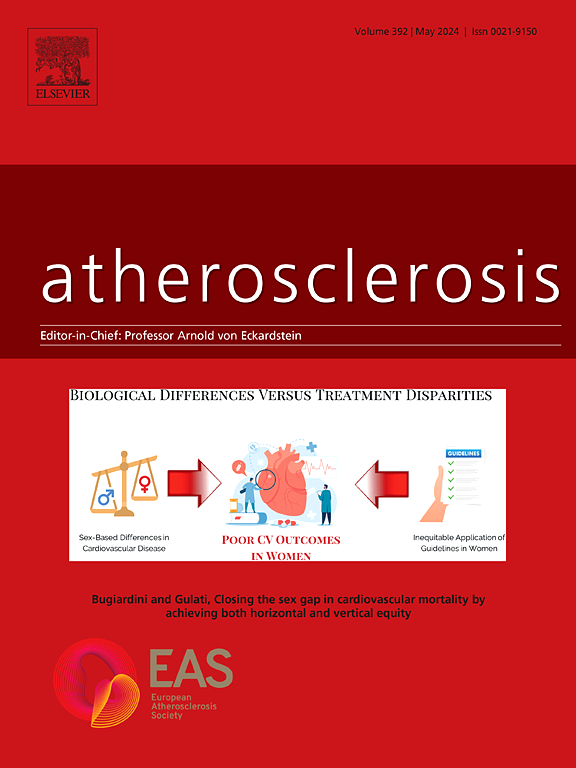Edgeworthia gardneri (Wall.) Meisn protects against HFD-induced murine atherosclerosis through improving gut microbiota-mediated intestinal barrier integrity
IF 4.9
2区 医学
Q1 CARDIAC & CARDIOVASCULAR SYSTEMS
引用次数: 0
Abstract
Background
Gut microbiota plays a crucial role in the development and progression of atherosclerosis. Edgeworthia gardneri (Wall.) Meisn, a member of the Thymelaeaceae family and the Edgeworthia genus, has been previously shown in our studies to attenuate atherogenesis when administered orally as an ethanolic extract (EEEG). However, the interaction between EEEG and gut microbiota, and the mechanism by which gut microbiota exerts anti-atherosclerotic effects, remains unclear.
Aims
This study aims to determine whether the anti-atherosclerotic properties of EEEG are associated with gut microbiota remodeling.
Method
Atherosclerosis was induced in ApoE−/− mice using a high-fat diet (HFD). The mice were treated with EEEG or Lactobacillus plantarum for 16 weeks. The composition of gut microbiota was analyzed through 16S rDNA sequencing. To assess whether the anti-atherosclerotic effects of EEEG depend on the gut microbiota, HFD-fed mice were treated with a cocktail of antibiotics or underwent fecal microbiota transplantation (FMT). Simultaneously, plaque areas in the aortic roots and whole aortas of apolipoprotein E deficient (ApoE−/−) mice were evaluated using oil red O staining and hematoxylin-eosin staining. Serum levels of LPS, fluorescein isothiocyanate-dextran, and expression levels of tight junction proteins were measured to identify the effects of EEEG on gut barrier dysfunction in HFD-fed ApoE−/− mice.
Results
The results revealed that EEEG treatment significantly reduced atherosclerotic lesions by ameliorating lipid accumulation and preserving gut barrier integrity. The protective effects were abrogated by antibiotics administration, concomitant with an increase in gut barrier permeability by decreasing expression of tight junction proteins. The microbial analysis indicated an augmented abundance of Lactobacillus, Turicibacter, Faecalibacterium, Akkermansia, and Desulfovibrio following EEEG treatment. Meanwhile, transplantation of fecal microbiota from EEEG-treated mice exerted the anti-atherosclerotic effect in the high-fat diet (HFD)-fed ApoE−/− recipient mice, accompanied by improvement of gut barrier integrity through upregulation of tight junction protein expression. Furthermore, exogenous supplementation of Lactobacillus plantarum mitigated AS in ApoE−/− mice and improved the gut epithelial barrier function by increasing the expression level of Zo-1.
Conclusion
These results suggest that the anti-atherosclerotic efficacy of EEEG is attributed to the preservation of gut barrier integrity mediated by gut microbiota. EEEG and its enriched Lactobacillus plantarum may be promising adjuncts for AS management.
Importance
Atherosclerosis (AS) is the primary pathological basis of cardiovascular disease (CVD). The gut microbiota is known to play an important role in the development and progression of atherosclerosis. In the clinical management of AS, pharmacological classes such as antioxidants, lipid-lowering drugs, and antiplatelet agents are commonly utilized. Despite their ability to decelerate the progression of AS, complications and adverse reactions still limit their application. Edgeworthia gardneri (Wall.) Meisn, a member of the Thymelaeaceae family and Edgeworthia Meisn genus, has been shown in previous studies to attenuate atherogenesis when orally administered as an ethanolic extract (EEEG). However, the interaction between EEEG and the gut microbiota, as well as the mechanism by which the gut microbiota exerts its anti-atherosclerotic effects, remain unclear. The significance of our research lies in identifying the mechanism behind the anti-atherosclerotic effect of Edgeworthia gardneri. The expected results will provide an important scientific basis for the clinical development and application of Edgeworthia gardneri in the prevention and treatment of AS.

求助全文
约1分钟内获得全文
求助全文
来源期刊

Atherosclerosis
医学-外周血管病
CiteScore
9.80
自引率
3.80%
发文量
1269
审稿时长
36 days
期刊介绍:
Atherosclerosis has an open access mirror journal Atherosclerosis: X, sharing the same aims and scope, editorial team, submission system and rigorous peer review.
Atherosclerosis brings together, from all sources, papers concerned with investigation on atherosclerosis, its risk factors and clinical manifestations. Atherosclerosis covers basic and translational, clinical and population research approaches to arterial and vascular biology and disease, as well as their risk factors including: disturbances of lipid and lipoprotein metabolism, diabetes and hypertension, thrombosis, and inflammation. The Editors are interested in original or review papers dealing with the pathogenesis, environmental, genetic and epigenetic basis, diagnosis or treatment of atherosclerosis and related diseases as well as their risk factors.
 求助内容:
求助内容: 应助结果提醒方式:
应助结果提醒方式:


